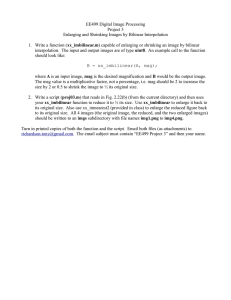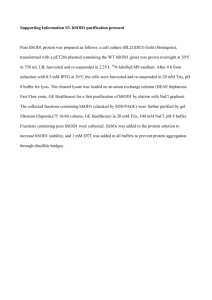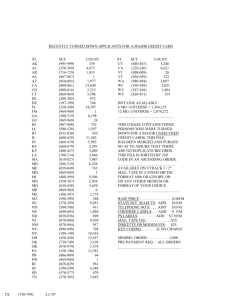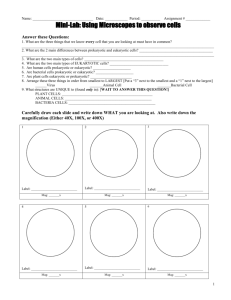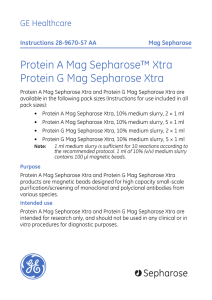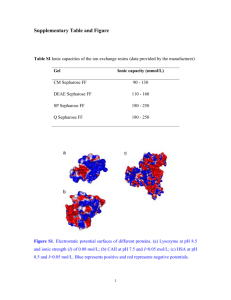Protein A Mag Sepharose™ Xtra Protein G Mag Sepharose Xtra
advertisement
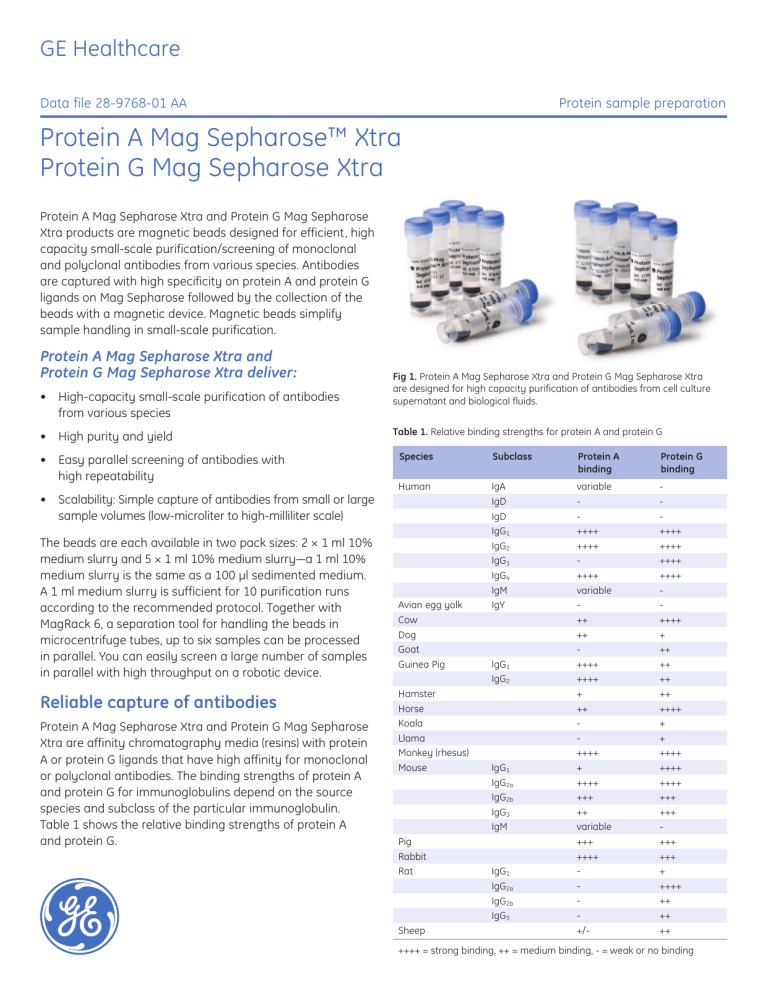
GE Healthcare Data file 28-9768-01 AA Protein sample preparation Protein A Mag Sepharose™ Xtra Protein G Mag Sepharose Xtra Protein A Mag Sepharose Xtra and Protein G Mag Sepharose Xtra products are magnetic beads designed for efficient, high capacity small-scale purification/screening of monoclonal and polyclonal antibodies from various species. Antibodies are captured with high specificity on protein A and protein G ligands on Mag Sepharose followed by the collection of the beads with a magnetic device. Magnetic beads simplify sample handling in small-scale purification. Protein A Mag Sepharose Xtra and Protein G Mag Sepharose Xtra deliver: • High-capacity small-scale purification of antibodies from various species • High purity and yield • Easy parallel screening of antibodies with high repeatability • Scalability: Simple capture of antibodies from small or large sample volumes (low-microliter to high-milliliter scale) The beads are each available in two pack sizes: 2 × 1 ml 10% medium slurry and 5 × 1 ml 10% medium slurry—a 1 ml 10% medium slurry is the same as a 100 µl sedimented medium. A 1 ml medium slurry is sufficient for 10 purification runs according to the recommended protocol. Together with MagRack 6, a separation tool for handling the beads in microcentrifuge tubes, up to six samples can be processed in parallel. You can easily screen a large number of samples in parallel with high throughput on a robotic device. Reliable capture of antibodies Protein A Mag Sepharose Xtra and Protein G Mag Sepharose Xtra are affinity chromatography media (resins) with protein A or protein G ligands that have high affinity for monoclonal or polyclonal antibodies. The binding strengths of protein A and protein G for immunoglobulins depend on the source species and subclass of the particular immunoglobulin. Table 1 shows the relative binding strengths of protein A and protein G. imagination at work Fig 1. Protein A Mag Sepharose Xtra and Protein G Mag Sepharose Xtra are designed for high capacity purification of antibodies from cell culture supernatant and biological fluids. Table 1. Relative binding strengths for protein A and protein G Species Subclass Protein A binding Protein G binding Human IgA IgD IgD IgG1 IgG2 IgG3 IgG4 IgM IgY variable ++++ ++++ ++++ variable ++ ++ ++++ ++++ + ++ ++++ + ++++ +++ ++ variable +++ ++++ +/- ++++ ++++ ++++ ++++ ++++ + ++ ++ ++ ++ ++++ + + ++++ ++++ ++++ +++ +++ +++ +++ + ++++ ++ ++ ++ Avian egg yolk Cow Dog Goat Guinea Pig Hamster Horse Koala Llama Monkey (rhesus) Mouse Pig Rabbit Rat Sheep IgG1 IgG2 IgG1 IgG2a IgG2b IgG3 IgM IgG1 IgG2a IgG2b IgG3 ++++ = strong binding, ++ = medium binding, - = weak or no binding Simplified handling The magnetic bead format has excellent properties for smallscale experiments. The high density of the beads allows rapid capture by magnetic devices while the visibility of the beads ensures reliable collection of the bound antibodies in the purification procedure. The products are provided with protocols optimized for antibody purification. MagRack 6 enables preparation of up to six samples captured in 1.5 ml microcentrifuge tubes (Fig 2). When the tubes are placed in the rack, the magnetic beads are attracted to the magnet within a few seconds. This allows easy removal of the supernatant whereas the magnetic beads are left in the tube. Ab SpinTrap Buffer Kit can be used to eliminate timeconsuming buffer preparations and this leads to fast and reproducible antibody purification. The characteristics of Protein A Mag Sepharose Xtra and Protein G Mag Sepharose Xtra are summarized in Table 2. Antibody binding capacity—a benchmark analysis A comparative benchmark analysis was performed at GE Healthcare Laboratories to investigate the binding capacity for antibodies using different magnetic beads products. We compared the performance of Protein A Mag Sepharose Xtra and Protein G Mag Sepharose Xtra with corresponding magnetic bead products from Millipore™, Invitrogen™, and Qiagen™ (Table 3). Human IgG and rabbit IgG were purified according to their manufacturer’s instructions (Table 3). All the media were subjected to an overloading test (i.e., the load of IgG was above the capacity for each media). Fig 2. The high density of the beads allows rapid capture by MagRack 6 magnetic device. Table 2. Characteristics of Protein A Mag Sepharose Xtra and Protein G Mag Sepharose Xtra Protein A Mag Sepharose Xtra Protein G Mag Sepharose Xtra Matrix Highly crosslinked spherical agarose (Sepharose) including magnetite Matrix Highly crosslinked spherical agarose (Sepharose) including magnetite Medium Protein A coupled NHS activated Mag Sepharose Medium Protein G coupled NHS activated Mag Sepharose Ligand Protein A Ligand Protein G Binding capacity > 27 mg human IgG/ml medium Binding capacity > 27 mg human IgG/ml medium Particle size 37 to 100 µm Particle size 37 to 100 µm Working temperature Room temperature Working temperature Room temperature Storage solution 20% ethanol, 10% medium slurry Storage solution 20% ethanol, 10% medium slurry Storage temperature + 4°C to + 8°C Storage temperature + 4°C to + 8°C Table 3. Experimental conditions for protein A media and protein G media Supplier GE Healthcare (GEHC) Millipore Qiagen Invitrogen Chromatography media Protein A Mag Sepharose Xtra and Protein G Mag Sepharose Xtra PureProteome™ Protein A and PureProteome Protein G Magnetic Beads BioMag™ Protein A and BioMag Protein G Dynabeads™ Protein A and Dynabeads Protein G Load Overloaded Overloaded Overloaded Overloaded Binding/wash buffer PBS (140 Mm NaCl, 2.7 mM KCl, 10 mM phosphate, pH 7.4) PBS (140 mM NaCl, 2.7 mM KCl, 10 mM phosphate, pH 7.4) 100 mM Tris-HCl, 150 mM NaCl, pH 7.5 PBS (140 mM NaCl, 2.7 mM KCl, 10 mM phosphate, pH 7.4) including 0.02% Tween 20 Elution buffer 100 mM glycine, pH 2.8 200 mM glycine, pH 2.5 200 mM glycine, pH 2.5 100 mM glycine, pH 2.8 28-9768-01 AA 2 A). Protein A magnetic beads 900 800 700 600 Yield (µg) The results show that Protein A Mag Sepharose Xtra and Protein G Mag Sepharose Xtra have considerably higher binding capacities for human IgG than the corresponding products from Millipore and Qiagen. Approximately 350 to 400 µg of purified human IgG was obtained in a single run with Protein A Mag Sepharose Xtra and Protein G Mag Sepharose Xtra (Figures 3A and 3B). 500 400 300 200 A). Protein A magnetic beads 100 0 450 GEHC GEHC Millipore Millipore Invitrogen Invitrogen Millipore Millipore Invitrogen Invitrogen 400 350 B). Protein G magnetic beads 900 800 250 700 200 Yield (µg) Yield (µg) 300 150 100 Qiagen Qiagen Qiagen Millipore Millipore Millipore GEHC GEHC GEHC 100 0 GEHC GEHC Fig 4. Purification of rabbit IgG using different protein A and protein G magnetic beads in a comparative performance evaluation. Each bar represents the amount of purified IgG obtained in a single purification run. 450 Repeatable antibody purification with high purity 400 350 300 Yield (µg) 400 200 B). Protein G magnetic beads 250 200 150 100 Qiagen Qiagen Qiagen Millipore Millipore Millipore GEHC GEHC GEHC 50 0 500 300 50 0 600 Fig 3. Purification of human IgG using different protein A and protein G magnetic beads. Each bar represents the amount of purified IgG obtained in a single purification run. Protein A Mag Sepharose Xtra and Protein G Mag Sepharose Xtra produced higher binding capacities than the corresponding products from Millipore and Invitrogen during the purification of rabbit IgG. For example, a single purification run resulted in 700 to 800 µg purified rabbit IgG (Figures 4A and 4B). 28-9768-01 AA To show the efficiency and repeatability of Protein A Mag Sepharose Xtra and Protein G Mag Sepharose Xtra, six replicate purification runs were performed (Table 4). The load was half of the total binding capacity for each medium. The antibody yield was consistently high (> 80%), and the purity analyzed by SDS-PAGE was > 90%. The data (Figures 5 and 6) shows that the purification runs on Protein A Mag Sepharose Xtra and Protein G Mag Sepharose Xtra were highly repeatable with a relative standard deviation (RSD) of < 2%. Table 4. Experimental conditions for Protein A Mag Sepharose Xtra and Protein G Mag Sepharose Xtra Sample Human IgG spiked in E. coli lysate Sample volume 300 µl Binding/wash buffer PBS (140 mM NaCl, 2.7 mM KCl, 10 mM phosphate, pH 7.4) Elution buffer 100 mM glycine, pH 2.8 3 Expression screening study A). Protein A Mag Sepharose Xtra 100 90 Recovery (%) 80 70 60 50 40 30 20 10 0 1 2 3 4 5 6 Purification run B). Protein G Mag Sepharose Xtra 100 90 We performed a comparative study using magnetic beads and a chromatographic column to determine the expression of human IgG1 produced in CHO cells (Table 5). Samples containing IgG1 were continuously taken out from a bioreactor during a two-week cell culture period. The samples were analyzed using Protein A Mag Sepharose Xtra beads and a 1 ml HiTrap MabSelect SuRe™ column and the data shows that the two techniques produced similar results (Fig 7). However, the use of Protein A Mag Sepharose Xtra had the following advantages over the 1 ml HiTrap MabSelect™ SuRe column: (i) Simplified handling of samples without the need for a chromatographic system, (ii) Ability to analyze several samples simultaneously thus reducing the total time required for analysis. Recovery (%) 80 Table 5. Experimental conditions for the expression screening study 70 60 Protein A Mag Sepharose Xtra HiTrap MAbSelect SuRe Medium volume 10 µl 1 ml Binding/wash buffer PBS (140 mM NaCl, 2.7 mM KCl, 10 mM phosphate, pH 7.4) PBS (140 mM NaCl, 2.7 mM KCl, 10 mM phosphate, pH 7.4), 0.05% Tween 20 Elution buffer 100 mM glycine, pH 2.8 100 mM sodium phosphate, pH 3.0 50 40 30 20 10 0 1 2 3 4 5 6 Purification run Fig 5. The recovery for six replicate purification runs was consistently > 80% (RSD < 2%). 10 µl sample 1.4 IgG1 conc. (mg/ml) 1.2 1 0.8 0.6 0.4 0.2 0 Protein A Mag Sepharose Xtra 1 2 3 4 5 Protein G Mag Sepharose Xtra Fig 6. SDS-PAGE stained with Deep Purple™ Total Protein Stain under reducing conditions. The purity obtained for six replicate runs was above 90% (RSD < 2%). 6 7 8 9 10 11 12 Sample Protein A Mag Sepharose Xtra HiTrap MabSelect SuRe Fig 7. Human IgG1 concentrations from a comparative performance evaluation of Protein A Mag Sepharose Xtra and HiTrap MabSelect SuRe. Note: Samples 1 to 3 were not analyzed using HiTrap MabSelect SuRe. 28-9768-01 AA 4 Purification of large volumes of low expression mouse IgG2b Two different protein A and protein G Mag Sepharose product lines One of the key advantages of magnetic bead purification is the ability to use different volumes of sample and medium slurry. In this study, low expressed monoclonal mouse IgG2b in 50 ml diluted cell supernatant (0.07 mg Ab/ml) was successfully purified and concentrated using 1.75 ml Protein A Mag Sepharose Xtra. The sample load was 3.5 mg and the experiment was performed in duplicate. The results show high specificity according to SDS-PAGE analysis (Fig 8) and recoveries of ~ 70%. The purified mouse IgG2b was concentrated from 50 ml to 3.5 ml. Protein A Mag Sepharose and Protein G Mag Sepharose are optimized for efficient enrichment of low abundant proteins by immunoprecipitation techniques. Protein A Mag Sepharose Xtra and Protein G Mag Sepharose Xtra are optimized for smallscale purification/screening of antibodies. For more information about Protein A Mag Sepharose and Protein G Mag Sepharose see Data file: Protein A Mag Sepharose, Protein G Mag Sepharose, NHS Mag Sepharose, GE Healthcare, 28-9539-39, Edition AA (2009). Table 6. Experimental conditions for Protein G Mag Sepharose Xtra Sample Mouse IgG2b from hybridoma cells Sample volume 50 ml (25 ml cell supernatant diluted with 25 ml binding buffer) Medium slurry volume 1.75 ml Binding/wash buffer PBS (140 mM NaCl, 2.7 mM KCl, 10 mM phosphate, pH 7.4) Elution buffer 100 mM glycine, pH 2.8 Low Molecular Weight marker Start sample (mouse IgG2b in cell supernatant) 97 000 Purified mouse IgG2b, second run Purified mouse IgG2b, first run 66 000 45 000 30 000 20 100 14 400 Fig 8. SDS-PAGE stained with Deep Purple Total Protein Stain under reducing conditions. The purification of 50 ml of low expression mouse IgG2b in a cell supernatant resulted in high purity (> 90%). 28-9768-01 AA 5 Ordering Information Products Quantity Code No. Protein A Mag Sepharose Xtra 2 × 1 ml 10% medium slurry 28-9670-56 Protein A Mag Sepharose Xtra 5 × 1 ml 10% medium slurry 28-9670-62 Protein G Mag Sepharose Xtra 2 × 1 ml 10% medium slurry 28-9670-66 Protein G Mag Sepharose Xtra 5 × 1 ml 10% medium slurry 28-9670-70 Related products Quantity Code No. MagRack 6 1 28-9489-64 Ab Buffer Kit 1 28-9030-59 HiTrap Desalting 5 × 5 ml 17-1408-01 PD MiniTrap G-25 50 columns 28-9180-07 His Mag Sepharose Ni 2 × 1 ml 5% medium slurry 28-9673-88 His Mag Sepharose Ni 5 × 1 ml 5% medium slurry 28-9673-90 His Mag Sepharose Ni 10 × 1 ml 5% medium slurry 28-9799-17 Protein A Mag Sepharose 1 × 500 µl 20% medium slurry 28-9440-06 Protein A Mag Sepharose 4 × 500 µl 20% medium slurry 28-9513-78 Protein G Mag Sepharose 1 × 500 µl 20% medium slurry 28-9440-08 Protein G Mag Sepharose 4 × 500 µl 20% medium slurry 28-9513-79 NHS Mag Sepharose 1 × 500 µl 20% medium slurry 28-9440-09 NHS Mag Sepharose 4 × 500 µl 20% medium slurry 28-9513-80 TiO2 Mag Sepharose 1 × 500 µl 20% medium slurry 28-9440-10 TiO2 Mag Sepharose 4 × 500 µl 20% medium slurry 28-9513-77 For your local office contact information, visit www.gelifesciences.com/contact GE Healthcare Bio-Sciences AB Björkgatan 30 751 84 Uppsala Sweden www.gelifesciences.com/sampleprep GE, imagination at work, and GE monogram are trademarks of General Electric Company. Deep Purple, HiTrap, MabSelect, MabSelect SuRe, and Sepharose are trademarks of GE Healthcare companies. BioMag and QIAGEN are trademarks of the QIAGEN Group of Companies. Millipore and PureProteome are trademarks of Millipore Corporation. Dynabeads and Invitrogen are trademarks of Invitrogen Corporation. © 2010 General Electric Company – All rights reserved. First published Jun. 2010. All goods and services are sold subject to the terms and conditions of sale of the company within GE Healthcare which supplies them. A copy of these terms and conditions is available on request. Contact your local GE Healthcare representative for the most current information. GE Healthcare Europe GmbH Munzinger Strasse 5, D-79111 Freiburg, Germany GE Healthcare UK Ltd, Amersham Place Little Chalfont, Buckinghamshire, HP7 9NA UK GE Healthcare Bio-Sciences Corp 800 Centennial Avenue, P.O. Box 1327, Piscataway, NJ 08855-1327 USA GE Healthcare, Japan Corporation Sanken Bldg., 3-25-1, Hyakunincho, Shinjuku-ku, Tokyo 169-0073 Japan imagination at work 28-9768-01 AA 06/2010
